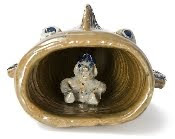
Next to music, it is perhaps the issue of the church pew that divides the traditionalists from the trendoids. I've seen debates over this simple, mundane piece of furniture lead to shouting matches and folks leaving the church. May I point out that, whatever your view on the pew, it's not worth that?
Pros:
1. Tradition - Some people have a visceral, positive reaction to a worship space containing pews, born most likely out of their prior religious experience. Pews, to them, look and feel like church.
But this applies to the 'unchurched' as well...as evidenced by the fact that many non-churchgoers want a church with pews for their wedding.
When pews have been in a church a long time, members may see them as imbued with the prayers and spiritual aspirations of congregants who have worshipped there before them.
If kneeling collectively is an important part of your church tradition, pews with kneelers are still the best way to accomplish it.
I think it's important to point out to Americans that in many European churches, the pews are part of the furnishings of a protected historic building and changing them is forbidden. This would apply to only a few congregations in the US.
2.
Flexibility - This is the pew's greatest practical strength. While pews are inflexible within the FLOOR space (see below), the SEAT space of the pew itself is very flexible. Because there is no designated, 24 inch seating area, as with a chair, a larger person can take up more space, and a smaller person less. A pew can be 'packed' for special events, temporarily expanding the sanctuary's seating capacity. Spacing is organically adjusted for relationships--families and couples can sit closer, or an appropriate personal space can be kept between strangers. Children can lie down on their parents' laps. I've noticed tired children shifting around in chair seating, unable to rest their head comfortably.
3.
Comfort - modern pews with padding are as comfortable as chairs. And do we really want to offer people the equivalent of a lazy-boy recliner, anyway?
4.
Expense - Though expensive new, pews that are used are widely available, often for free or just for transport.
5.
Underlying spatial philosophy - pews are 'shared', chairs are your 'own'.
Cons:
1. Tradition - Some people have a visceral, instinctive dislike of a worship space containing pews, again, likely due to past religous experience. It also seems, however, to be a reactionary position taken up by long-time churchgoers without particularly bitter memories in an effort to be somehow modern. Is it possible to be a 'modern' church using 'traditional' furniture?
2. Flexibility -This is the pew's greatest practical drawback. If you want to use the sanctuary space for more than one purpose, or use a lot of different worship space configurations, it's tough to move pews and nearly impossible to store them. Pews don't stack well.
3.
Comfort - There is no doubt that vintage or antique pews were made for people of a smaller average size than those of today. And they'd never heard the word 'ergonomic'.
4.
Expense - New pews are much more expensive than new chairs.
5. Underlying spatial philosophy - pews are 'shared', chairs are your 'own'
My take:
If your pews have a long historic tradition in your congregation, keep them and modernize in other ways. The costs of discarding your history are too high. Try to add padding and footrests for additional comfort if you can.
If you really need to completely reconfigure your sanctuary frequently (at least once a month), chairs are the only and obvious choice.
It's been my experience, however, that many churches think they'll do this and then never do, usually because moving alot of chairs is really hard work. (Believe me, I know. It is not uncommon for the pastor's family to pull janitor duty). If you are using chairs in fixed positions (which is like pews anyway), the clean, strong line of a pew is more aesthetically pleasing, and will allow the aforementioned flexibility within the
seating space.
Personally, I wouldn't even consider fixed, theater style seating, which has the immovability of pews but none of their flexible-spacing advantages. It combines the worst of both options.
If you're buying, consider specifying shorter pew sections combined into longer lengths, as it is the long pews that are the most inflexible within the floor space. Consider areas (around the stage? near the back? a flexible central area?) where you might want to remove or change seating for special events and use chairs there. This can also be done in sanctuaries with existing pews, where replacing selected pews with chairs can increase the options for floor arrangments, allowing for instance, a circling of chairs around the stage for smaller gatherings.
And that brings me to my final thought, why is it pews OR chairs? A combination of the two would work well for many churches.
Pews/no-pews can't answer what it means for a church to be relevant in the modern era. It's not even the right question. What is at issue here is simply the practical consideration of what seating style is best for your church.

























